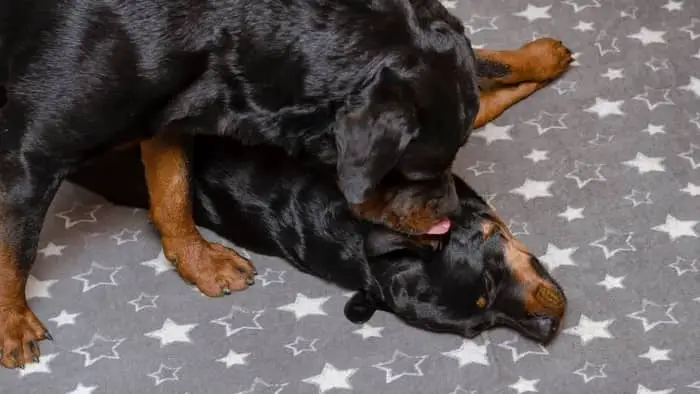Last Updated on April 24, 2024 by Dr. Julie
It is critical to know the Rottweiler’s first heat symptoms to learn its heat cycle as it’s an extraordinary period for your dog.
During a Rottweiler heat cycle, you will notice that she will act differently than usual, so it’s best to learn what is going on with her and how to handle her.
Table of Contents
When Do Rottweilers Go Into Heat?
A Rottweiler dog goes into her first heat between 6 and 12 months old. The heat cycle repeats every 6 months and lasts for about 3 weeks. The most common time is around 9 months.
It is also possible for your Rottweiler to experience its heat cycle much later as some large breed dogs might go into first heat at 18 to 24 months of age. In the beginning, heat cycles can be irregular but tend to normalize within the first two years.
If you plan to breed your Rottweiler, remember she won’t be sexually mature before 18 months. It is not recommended to breed your Rottweiler before the second or third heat cycle.
If you breed immature Rottweiler, their pregnancy can bring numerous health complications. The young mother may also reject her puppies and have no intention to take care of them.
What Are Rottweiler’s First Heat Symptoms?
The general heat symptoms to note are bloody discharge, swollen vulva, and excessive licking of the genital area. There could also be some behavioral and appetite changes.
A Rottweiler’s first heat symptoms are apparent, and you won’t need much effort to learn how to recognize them. Every dog on heat goes through three critical stages – Proestrus, Estrus, and Diestrus.
The Proestrus Stage
This is the first stage during which your dog’s body is getting ready to mate. Physical changes are typical and expected, including bloody discharge, swollen vulva, excessive licking of the genital area, and frequent urination. Your Rottweiler girl is not in the mood to mate during this first stage. She may be aggressive toward the males who, on the contrary, will be highly interested in her. During this stage, you will also notice some behavioral changes. Your Rottweiler girl may experience a reduced appetite, lack of energy; develop a clingy behavior from separation anxiety.
The Estrus Stage
This is the second and the most challenging period. Your female dog is in the mood to mate and hangs around boys during the phase. She moves her tail to the side, meaning she is available to the male dog. This is known as flagging behavior – she is calling for the male’s attention. You will notice that the swelling of the vulva is reduced but still exists. The swelling makes the vulva soft enough for penetration during intercourse. By now, the bleeding has stopped or only exists in traces. The discharge may become watery, meaning your Rottie girl is at the most fertile time of her cycle. This is the period of ovulation, and your Rottie can get pregnant. It is a difficult period for those who don’t want kids. In this second stage, your Rottweiler girl will be very loud. She will often howl, which is not a sign of pain or sadness as people interpret it but an invitation to male friends from the neighborhood. She will also be very needy of attention from you and might show a significant interest in one particular toy. All this strange and crazy behavior shall end in 7 to 10 days.

Learn more about: Female German Rottweiler Names For Your Next Pet
The Diestrus Stage
This is the third stage of the heat cycle, whereby the body is returning to normal again. The vulva is no longer swollen, and there is no discharge coming out, and your Rottie girl goes back to her usual self.
This heat phase lasts about 2 months from the beginning to the end.
How Often Do Rottweilers Go Into Heat?
Rottweilers dogs usually go into heat at least 2 times a year or every 6 months. This varies with each dog as these large dogs may go into heat less frequently than other breeds.
How Long Do Rottweiler Dogs Bleed While On Heat?
There is no significant difference between large and small breeds when it comes to bleeding during the heat cycle. A Rottie girl can bleed between 4 days to 2 weeks.
The bloody discharge that is red is characteristic of the Proestrus – the first phase of the heat cycle. Although her body is getting ready to mate, she won’t be receptive to males. Even so, it would help if you kept a close eye on her all the time.
Some light bleeding continues after the first phase. However, in the second phase – Estrus, the discharge is pale in yellow or pink and less in amount. Unless your Rottie girl has a very heavy flow, you might not see a single drop of blood. They tend to lick their genital area very clean during the heat period, so they might not create any mess.
When Should You Spay Your Rottweiler Dog?
Unless you intend to breed your Rottweiler girl, you should spay her. The right time for spaying is around the second year. Even though the procedure can be done when she turns 1, it’s not recommended. A spaying procedure that has been done too early might cause your dog to suffer from bone cancer in her old age.
Spaying procedures can be done even during the heat, although most vet surgeons do not like this option due to its many risks. Consult your vet to get the most reliable advice about this procedure before it’s done.
The spaying procedure removes the uterus and the ovaries, meaning your dog will never get cancer-related to these organs. Spayed dogs are less aggressive, not to mention that your Rottie girl will not be going through all that behavioral and physical changes every 6 months.
Read more about Length Of Rottweiler Gestation Period.
Conclusion
Now that you know when your Rottweiler’s first heat symptoms are, it’s vital to keep an eye on your furry girl when she is on heat.
Your Rottie girl may take a while for her cycle to become regular. It’s a good idea to record the days she gets her cycle and the symptoms you notice to present it to the vet.
Smaller breeds may go into heat more frequently, as often as 3 to 4 times each year, while larger dogs like Rottweilers will go into heat once a year or once every 12 to 18 months.
Rottweilers will experience the estrus throughout their lives, although the time between the cycles tends to get longer.
